|

|

FLIGHT DAY: Countdown • 1 • 2 • 3 • 4 • 5 • 6 • 7 • 8 • 9 • 10 • 11 • 12 • 13 • 14

- Discovery is NASA's oldest flying orbiter. Built after Columbia and Challenger, Discovery returned the fleet to flight after the 1986 and 2003 losses of its older shuttle siblings.
- With 39 flights, Discovery is the most-flown spacecraft in history.
- The solid rocket boosters launching Discovery's STS-133 mission were assembled from segments flown on 54 earlier space shuttle missions, including both of Discovery's return to flight missions.
- Discovery's three main engines have flown on 21 previous flights, including Discovery's 1998 mission STS-95 that returned Senator John Glenn to space.
- When first announced by NASA in September 2009, the STS-133 astronauts were billed as "the crew for the final scheduled shuttle mission." In April 2010, the agency rescheduled Discovery's final mission, STS-133, to fly before Endeavour's, STS-134.
- The Permanent Multi-Purpose Module (PMM), which Discovery is launching and attaching to the space station, has flown in space seven times before. Known earlier as the Leonardo Multi-Purpose Logistics Module, it served as a "moving van" to deliver supplies and equipment to the station.
- Although the STS-133 crew are all veterans of spaceflight, this will be mission specialist Michael Barratt's first time riding onboard a shuttle. For his first mission, during which he spent six months on the space station, Barratt flew on a Russian Soyuz spacecraft.
- Mission specialists Michael Barratt and Nicole Stott learned they were assigned to STS-133 while they were still conducting their previous mission onboard the space station, marking the first time in history when astronauts in orbit were named to their next flight.
- Mission specialist Stephen Bowen is the first NASA astronaut to fly on consecutive missions. Having flown onboard Atlantis' STS-132 mission last May, Bowen was added to Discovery's STS-133 crew after astronaut Tim Kopra was injured in a bike accident less than six weeks from launch.
- Prior to flying STS-133, Discovery logged 142,917,535 miles while orbiting the Earth 5,628 times over the course of 351 days.
- This is Discovery's 13th trip to the International Space Station. It also visited Russia's Mir space station once.
|
Update for Nov. 4, 10 p.m. CDT: The rotating service structure on Pad 39A was temporarily retracted on Thursday evening to again cover space shuttle Discovery as technicians repaired paper (Tyvek) weather covers on two of the orbiter's forward reaction control, or maneuvering, thrusters. The work, according to NASA public affairs, will not interfere with Friday's launch attempt.
In preparation for the scheduled launch of space shuttle Discovery on its final mission, the rotating service structure at Pad 39A was retracted on Wednesday (Nov. 3) evening.
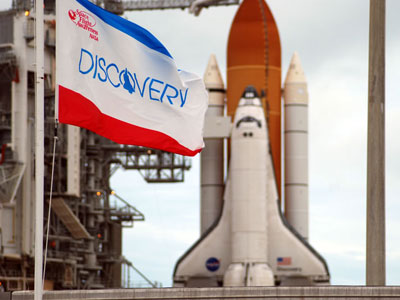
Discovery's flag flies at the pad. Click for photo gallery. Credit: collectSPACE
The weather, which delayed Discovery's liftoff by 24 hours Thursday, is forecast to have a 60 percent chance of acceptable conditions Friday. At concern are high winds in the wake of a cold front moving through central Florida.
Friday's launch time is 3:04 p.m. EDT.
|
Update for Nov. 5, 5:15 a.m. CDT: Fueling of Discovery's external tank with 535,000 gallons of liquid oxygen and hydrogen is now underway. The process began ten minutes late (per NASA's schedule) at 5:58 a.m. EDT but the delay won't impede today's countdown.
Space shuttle mission managers met at 5 a.m. EDT and gave a "go" to begin loading Discovery's external tank with more than 535,000 gallons of liquid oxygen and liquid hydrogen. The operation is set to begin shortly.
The weather forecast has improved from yesterday. There is now a 70% chance of favorable conditions at launch time. The primary concern is for high winds at Pad 39A and Shuttle Landing Facility (SLF). The weather is forecast "go" at all three Transatlantic Abort Landing sites.
The STS-133 astronauts woke at 4:20 a.m. EDT and are soon to undergo pre-launch medical checks. T-minus six hours and counting...
|
In the process of fueling Discovery's external tank, a hydrogen gas leak was detected emanating from the ground umbilical carrier plate (GUCP), an attachment point between the external tank and a 17-inch pipe that carries gaseous hydrogen away from Discovery to the flare stack, where it is burned off.

Credit: NASA TV
Mission managers are assessing the leak and have slowing the flow of liquid hydrogen into the tank. A similar problem delayed the launches of two earlier shuttle missions, STS-119 and STS-127 in March and June of last year.
|
Shuttle managers scrubbed Discovery's launch attempt for today at 8:11 a.m. EDT due to hydrogen leaking from the ground umbilical carrier plate (GUCP, pronounced "gup").
The GUCP serves as the attachment point between the external tank and a 17-inch pipe that carries gaseous hydrogen away from Discovery to the flare stack, where it is burned off.
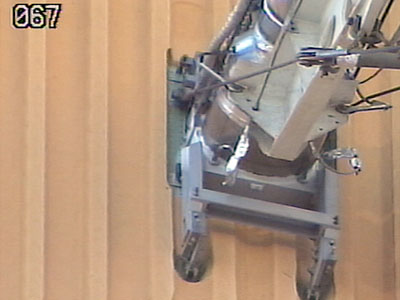
Ground Umbilical Carrier Plate (GUCP) Credit: NASA TV
The external tank is now being drained of the liquid oxygen and hydrogen that it was loaded with earlier this morning.
It will take at minimum of 24 hours to safe Discovery so that technicians can gain access to the GUCP to survey the area and begin repairs.
"We won't know what's gone wrong with the GUCP until we get our hands on it, which will be tomorrow afternoon sometime. Right now it's a lot of speculation, but the hardware was obviously talking to us, it leaked a significant leak, so it was a case where we were not only violating launch commit criteria but also ground safety requirements," said launch director Mike Leinbach.
Discovery's next launch attempt will come no earlier than Monday, Nov. 8. The STS-133 launch window was earlier announced as closing Sunday but mission managers said they were assessing the possibility of adding the additional day.
"A lot of us believe that given the magnitude of the leak we're going to see something obvious when we get it apart," said Leinbach. "If that's the case, we will changeout whatever is wrong, put it back to together, and hopefully that supports Monday."
If a launch Monday at 12:53 p.m. EST is not possible, then Discovery's next window will open on Nov. 30 and extend to Dec. 5.
A similar hydrogen leak from the same area delayed two shuttle missions last year, STS-119 in March and STS-127 in June.
|
NASA has decided to postpone the next launch attempt for space shuttle Discovery to no earlier than Nov. 30 at 4:05 a.m. EST.
Deferring the launch to the beginning of the next window will give space shuttle engineers the time to repair not only the gaseous hydrogen leak that led to Friday's scrub, but also a seven-inch crack in the external tank (ET) that was found after the launch countdown was halted.
"The hydrogen leak may have been a lucky break," astronaut Alvin Drew wrote on the social network Twitter. "Found a crack in the ET outer foam with ice underneath. Don't know that we'd have caught it."
Mission management team chair Michael Moses was confident the crack would have been found, though whether it would have also resulted in a scrub is still to be seen.
"Normally, after we tank, we'd send the final inspection team out, the ice team. They'd take a real close look at the tank, see how its doing with all the cryogens in there, make sure the foam is behaving itself, make sure there is no ice [but] since we didn't launch and and load the crew in, that team didn't go out until after we drained. But they did go out and look at the tank and in doing so they detected a crack," said Moses.
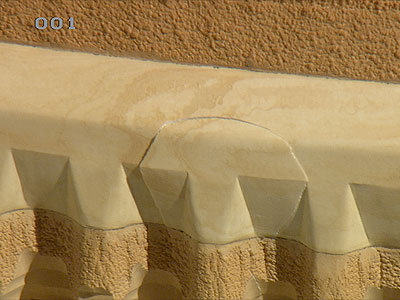
The foam crack in Discovery's external tank. Credit: NASA
The crack, which is offset from the rest of the foam increasing the risk of ice formation, is located near the upper attachpoint between the tank and Discovery on the flange between the intertank and liquid oxygen tank.
"I don't know if that would have passed our criteria if we would have been 'go' for launch but it certainly would have been something that would have generated a whole lot of discussion," Moses said.
"The teams will take a look and see what happened and we'll look to see what we have to do, both in terms of what caused it and needs to be adjusted or fixed to [prevent it] and what needs to be done to this tank to fix that crack before we go forward," he added.
It is too early to know if the repair to the crack can be made at the pad or if Discovery will need to be rolled back to the Vehicle Assembly Building.
At the same time, the gaseous hydrogen leak emanating from the ground umbilical carrier plate (GUCP) needs to be assessed, even though earlier shuttle missions experienced a similar problem.
"This one looks different than those, even though it is still a leak at the GUCP," explained Moses. "This one had a much, much higher rate and showed up a little earlier than we had seen in the past, which leads us to believe that hopefully -- it's a strange thing to hope for, right? -- hopefully something is glaringly wrong with the GUCP as opposed to we don't quite understand what the problem is. But we're not going to know that until we get out there and take a look at it."
The decision to postpone the launch to the next window was based on the work needed to address the GUCP and came before Moses learned of the foam crack.
"We want to make sure we go fix this and understand why it is leaking in the first place, so we can help insure it won't happen any more. We need to take our time while we do that. We don't want to rush through it trying to get to a Monday launch," he said.
Along those same lines, Nov. 30 is -- at least for now -- only tentatively the new launch date.
"We need to wait and actually see what is going on with the GUCP and let the teams go take a look and see how they are going to repair it. We suspect that by then it is plenty of time to fix that problem but you just never know what you are going to find," said Moses.
"We have a lot to do before we settle in on a new launch date."
Leaving the engineers to do their work, Discovery's STS-133 crew left the Kennedy Space Center at around 2 p.m. EDT, flying their T-38 jets back to the Johnson Space Center.
"Got a T-38 to Houston scheduled for this afternoon instead of a shuttle to ISS," tweeted Drew.
|
Space shuttle engineers met for a series of meetings Monday to discuss options for inspecting and repairing Discovery's ground umbilical carrier plate (GUCP) and a crack in shuttle's external tank foam insulation.
After extending an access platform on Pad 39A, technicians have been measuring the alignment of the plate on the external tank and performing leak checks. Disconnection of the GUCP is expected Tuesday afternoon after separating the hydrogen vent line that is attached to it.

Technicians survey the GUCP. Credit: NASA TV
Mission managers will assess repair options after the disconnected plate is inspected.
Teams have also begun analysis and inspection of the approximately 20 inch long crack in the external tank foam. The plan is to use terahertz or backscatter scans to see beneath the foam to look for any other potential issues.
As soon as Wednesday, technicians could begin dissecting the cracked section so foam experts can make a thorough evaluation in order to help determine its cause. Teams still are working out plans to reapply foam to the tank after the inspections are complete.
|
Technicians will begin disconnecting Discovery's ground umbilical carrier plate (GUCP) Tuesday evening by unhooking and lowering the hydrogen vent line that attaches to it on the external tank.
Wednesday, crews will begin to remove the seven-inch quick disconnect, waiting until morning to take advantage of the daylight in order to assist in their visual inspections.
The hardware will be removed and inspected, but not reinstalled. Instead, the equipment will be replaced with hardware known to have not leaked in the past.
Meanwhile, inspections and analysis of the 20-inch crack in the external tank foam continue.
Tuesday, technicians took samples of the foam, which will be dissected for analysis tonight. Terahertz scans will begin Thursday to see beneath the foam to inspect for other potential issues.
Teams still are working out plans to repair the crack and reapply foam to the external tank after their inspections are complete.
|
Wednesday morning, during the removal of foam insulation from space shuttle Discovery's external tank, technicians identified two cracks on a section of the tank's metal exterior.
The approximately nine-inch long cracks were found running along one of the stringers, the vertically-orientated, composite aluminum ribs installed on the tank's intertank area.

Metal cracks in Discovery's external tank. Click to enlarge. Credit: NASA
Engineers are reviewing imagery of the cracks to determine how best to repair them.
"They're looking at the best repairs that can be done at the launch pad," Kennedy Space Center news chief Allard Beutel told collectSPACE.
Repairs to similar cracks have occurred during production of the external tanks at the Michoud Assembly Facility in New Orleans. The work was accomplished by removing the cracked aluminum and replacing it with a "doubler," a twice-as-thick stringer section.
"They've obviously never done that here, let alone at the pad, but that is what they are looking at right now," said Beutel. "This is so new that the exact schedules and repair options are still being evaluated."
"But [the cracks] were what they anticipated they would find when they got down to the surface, based on previous experience. So what that did at least tell them is that the foam did exactly what was expected... as opposed to having some unknown method that caused it," he said.
Meanwhile, work is continuing elsewhere on the space shuttle to remove and replace the ground umbilical carrier plate (GUCP) -- the source of the hydrogen leak that led to last Friday's launch scrub -- and circuit breakers behind a panel in Discovery's crew cabin that were deemed suspect of an earlier problem.
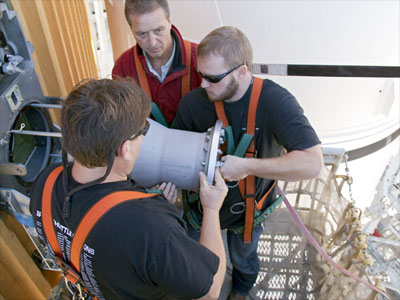
Technicians remove the GUCP quick disconnect. Credit: NASA
Technicians began disconnecting the GUCP Tuesday night by unhooking and lowering the hydrogen vent line that attaches to the plate. They then removed the seven-inch quick disconnect today.
"They are going to [install] a new quick disconnect and new seals," said Beutel, adding that they expect that work will be completed by the end of the week.
Work inside Discovery's crew compartment replacing the circuit breakers behind panel L4 is set to begin Friday, once the GUCP work is complete.
"They will switch out the circuit breakers in that particular panel and fully re-test it by early next week," Beutel explained.
Despite the work ahead, NASA is still aiming for the next launch window to begin Discovery's final flight to space.
"We're still moving toward that no-earlier-than launch date opportunity of Nov. 30, but how this all plays out is still being evaluated," said Beutel.
|
Overnight, crews removed Discovery's ground umbilical carrier assembly, or GUCA, which includes the flight seal, seven-inch quick disconnect, or QD, and the carrier plate, known as the GUCP, as they continue working to investigate the gaseous hydrogen leak that led to the Nov. 5 scrub.
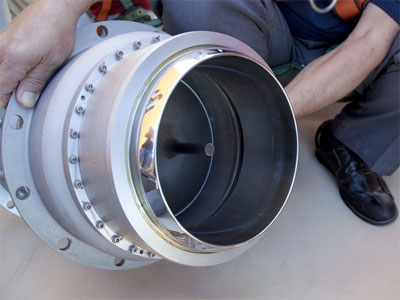
GUCP quick disconnect. Credit: NASA
Engineers performed an initial inspection of the flight seal and QD before sending them to labs for a thorough analysis. They reported some areas of interest, explained Kennedy Space Center news chief Allard Beutel.
"Regarding the flight seal and some of the interior [to the QD] alignment, they were not properly aligned," said Beutel in a telephone interview with collectSPACE. "Why that happened, how that came about, that is what they are off trying to determine."
Pending the results of that evaluation, the new GUCA could be ready for installation on Friday.
"They are working to approve a plan that would allow them to go back in by tomorrow, put a new flight seal in, put the carrier plate assembly back on and basically wrap up the replacement of the GUCP, the fitting and all the connectors over the weekend and be ready by early next week," said Beutel.

A technician examines cracks in the external tank. Credit: NASA
Meanwhile, a repair plan is coming together to address the cracks found in an aluminum lithium stringer on the external tank.
The plan, which has been executed before at the tanks' assembly facility in New Orleans, consists of cutting out the cracked section and replacing it with an available piece that matches its size. A "doubler," or second piece of aluminum for reinforcement, will be inserted before the mounting rivets to complete the repair.
Foam insulation then will be formed over the newly repaired stringer and will require about four days to cure.
"They need to build an enclosure [around the repaired area] to re-foam it and to maintain the proper atmospheric conditions," said Beutel. "It takes four days [for the foam] to dry... and that assumes you're not going to get a storm blowing through here."
Engineers will meet Friday to discuss the status of the repairs underway.
|
Space shuttle technicians on Friday working to remove foam and inspect Discovery's external tank identified an approximately three-inch crack on the left-hand adjacent aluminum stringer to the one found earlier with two nine-inch cracks.
The stringers are the support strips on the outside of the external tank that form the intertank, the section between the inside liquid oxygen tank and the liquid hydrogen tanks.
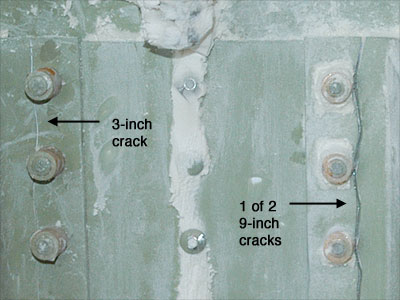
Three-inch crack found in adjacent stringer. Credit: NASA
"To the engineers, this was not entirely unexpected," explained Kennedy Space Center news chief Allard Beutel to collectSPACE. "When the load exceeded the initial stringer, which caused it to crack, it transferred its load to adjacent stringers, as they are designed to do, and one of them cracked."
Teams will take the weekend to build and use existing structural math models to understand how the loading affected the adjacent stringers.
Similarly, the technicians working to install a new ground umbilical carrier assembly (GUCA) will defer the work they had planned over the weekend to take additional measurements to ensure the best possible alignment of the newly installed ground umbilical carrier plate (GUCP).

Workers begin to install the new GUCP. Credit: NASA
"The whole thing with the GUCP is proper alignment," said Beutel. "When it is properly aligned, it doesn't leak. So they are going to take extra time to make sure they get really good measurements before they put the quick disconnect and [flight] seal back in."
Teams will meet again on Monday to evaluate the data collected and now expect to begin installing the seal and quick disconnect on Monday.
|
While continuing to remove foam from the damaged area of space shuttle Discovery's external tank in preparation to begin their repairs, technicians uncovered a second three-inch crack in the aluminum stringer adjacent to the first support strip that was found to be fractured.
"They found a corresponding crack on the same left-hand stringer where we found the three-inch crack on Friday," Kennedy Space Center news chief Allard Beutel said. "When they removed the foam from the top of the [stringer], they found on the opposite or mirror-side of the same beam a corresponding crack."
"There are still two stringers, the initial one that had the nine-inch cracks and the one immediately to the left had two, three-inch cracks."
According to Beutel, an inspection of the stringer to the left of the second cracked strip revealed no damage. Similarly, the beam to the immediate right of the stringer with the nine-inch cracks was also intact.
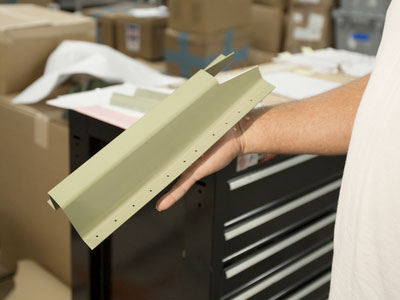
A "doubler" to be installed on the external tank. Credit: NASA
Working toward a repair, technicians have removed the top of the stringer encompassing the nine-inch cracks and will do the same for the strip with the three-inch cracks. "Doublers," or twice-as-thick aluminum strips, are being fabricated and will be installed prior to the re-application of foam.
A plastic environmental enclosure has been erected around the work area to facilitate the foam curing -- or drying -- once applied.

A technician climbs to the environmental enclosure. Credit: NASA
Meanwhile, work continues on installing the new ground umbilical carrier assembly (GUCA), replacing the slightly-misaligned hardware that leaked gaseous hydrogen causing the Nov. 5 launch scrub.
A new carrier plate and flight seal were installed on Friday. Today, teams were given the go to begin installing the new quick disconnect hardware.
Beutel said managers are leaning toward performing a "tanking test" once the GUCA and foam repairs are complete. If approved, the external tank would be loaded with cryogenic propellants just as it would be on launch day so that engineers can observe how the mended tank performs.
|
Tuesday, technicians installed the new quick disconnect hardware for the recently-replaced ground umbilical carrier plate (GUCP) that will connect Discovery's external tank to Launch Pad 39A. The original hardware was culprit in a gaseous hydrogen leak that resulted in scrubbing the Nov. 5 launch attempt.
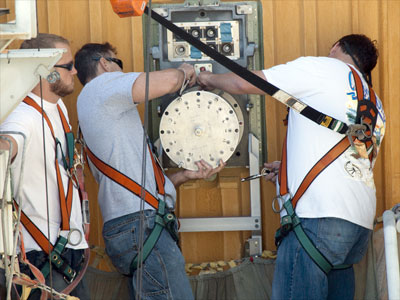
Workers install the new 7-inch quick disconnect. Credit: NASA
Another team of technicians is working on repairing cracks on the tops of two, 21-foot-long support beams, called stringers, on the exterior of the tank in an area referred to as the intertank. The team includes personnel from the tank's manufacturing plant in Louisiana, the Michoud Assembly Facility.
Engineers continue evaluating the intertank for any potential issues, but so far no other cracks have been found beyond the ones on the two prior identified stringers. There are a total of 108 stringers on the intertank.
Senior managers plan to meet Nov. 22 at Johnson Space Center and via video conference for a launch status briefing to assess the repair work and launch preparations. Although managers have not set a new target date for Discovery’s STS-133 mission to the International Space Station, the repair work and planning are still aimed at supporting an attempt in the upcoming launch window that opens Nov. 30.
|
Space shuttle Discovery's final launch will now take place no earlier than Friday, Dec. 3 at 2:52 a.m. EST.
"[Mission managers] wanted to give the teams more time," NASA public affairs officer Candrea Thomas told collectSPACE. "They have got to do a review of the flight rationale."
"The analysis is going to be in work for the next five days. They'll review that at a special [program requirements control board meeting], which is going to be next Wednesday on the 24th. Once a successful review of the flight rationale is done at that meeting, then they will hold the launch status briefing with senior NASA management on Monday the 29th," she added.
In the meantime, the repair work is nearing completion or, as in the case of the ground umbilical carrier plate (GUCP), has been completed.
"The GUCP work is complete," said Thomas. "They did leak checks last night and it did not leak."
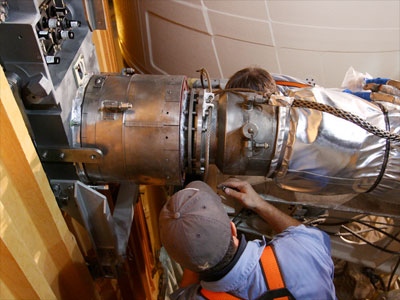
Workers reattach the hydrogen vent line to the GUCP. Credit: NASA
On Wednesday evening, technicians completed two sets of leak checks with the gaseous hydrogen vent line attached to the GUCP, following the hardware being replaced to repair a gaseous hydrogen leak that resulted in Discovery's Nov. 5 launch attempt being scrubbed.
The leak checks were done at ambient temperatures, including one at a higher-than-standard pressure to rigorously test the repairs.
Technicians have also completed changing out circuit breakers behind a panel in Discovery's crew compartment. The circuitry was suspected to be the culprit behind an earlier issue encountered with Discovery's no. 3 main engine.
Remaining in work is the repair to two cracked support beams located on the intertank area on Discovery's external tank.
Teams on Thursday were working to install new sections of metal, called "doublers" because they're twice as thick as the original metal, to replace the two cracked stringers. After that is complete, technicians will reapply foam, replacing the cracked and surrounding areas of insulation that they removed in order to expose and repair the stringers.
"Foam application right now is planned to begin Saturday afternoon," said Thomas. The foam will then need four days to cure, or dry.
If mission managers approve the stringer and other repairs, setting Dec. 3 as the first launch attempt, then they'll have three days in which to get Discovery off the ground prior to the window closing.
|
Space shuttle Discovery's external tank has been returned to flight-ready condition, with its cracked stringers, or support beams, patched and new insulation foam applied over the damaged area.
Technicians completed final inspection scans of their stringer repair work on Monday. The environmental enclosure, which was erected on the side of the tank to support foaming operations, was removed today.
The primary repair consisted of the installation of new sections of metal, called "doublers" because they are twice as thick as the original stringer metal, to replace two cracked beams. The damage, which first presented itself as a cracked section of the foam covering the stringers, had been seen with earlier tanks but this was the first time it was discovered after the vehicle was on the launch pad.
Program managers will review the analysis and repairs that are required to safely launch Discovery on its final mission during a special Program Requirements Control Board meeting Wednesday. Pending a successful review of the flight rationale, senior NASA leaders will convene a launch status briefing on Monday, Nov. 29 to decide when the STS-133 mission will begin.
|
Space shuttle Discovery's final launch will now take place no earlier than Friday, Dec. 17 and, pending the continuing analysis of the damage and repairs to its external tank, could be further delayed into early next year.
NASA's shuttle program requirements control board reviewed Wednesday the repairs and engineering evaluations associated with cracks found on two 21-foot-long U-shaped aluminum stringers installed vertically on the tank's intertank area. Despite the cracks being repaired using methods that were earlier certified for flight, managers decided that more analysis and tests were required before Discovery could be launched safely.
"We would have liked to have found a most probable cause by now and things would be a lot more straightforward," Bill Gerstenmaier, associate administrator for space operations, said during a press briefing. "This is turning out to be a little more complicated from an analysis standpoint and it doesn't easily lend itself to a very easy answer."
The issue is not that the stringers cracked; cracked stringers have been found and repaired in 31 previous cases, each having flown safely. All of them however, occurred during assembly of the tanks, not on the launch pad as in this situation. While engineers feel they understand the reasons for the earlier cracks, they have yet to solidly determine what caused the stringers on Discovery's tank to break and if it could happen again.
"It is not a design issue. That is something we have re-verified over the past week," said shuttle program manager John Shannon. "If a stringer is properly assembled, it will carry that load and not have a problem."
According to Shannon, that left two questions about the cracks found on the pad.
"Did we have an escape in our inspection methods that allowed a flaw to get into the assembly of the intertank... or did [we] have some kind of an assembly misalignment that could add additional stress," he explained.
The hope, said Shannon, was that they would find a flaw in the material used to fabricate the stringers and that the stress imparted by the loading of the cryogenic propellants was the maximum stress that that part saw throughout the entire flight phase.
"Neither one of those points are as clear as we needed [them] to be to commit to go fly," he said.
"We have an unknown here -- how did something get through our process and get to the launch pad to allow a crack? And then, do [we] have a susceptibility to have another one of those kind of conditions?" explained Shannon.
The latter is of particular concern if the cracks were caused by the stress of the launch, rather than the loading of propellants on the pad.
"If that happened, could it crack the foam?" raised Shannon. "And if that happened, could that foam be dislodged and hit the vehicle, which is where our main concern is?"
Further, added Shannon, is the concern over how many of the stringers could crack before the tank would suffer a structural failure.
To resolve these questions, teams are off studying the full history of the stringers, from fabrication through installation, as well as data mining the prior cracks to gain a better understanding what assembly methods led to them occurring. They are also testing stringer and intertank material to try to induce cracks and reviewing imagery to verify they haven't missed the development of cracks in the same area on earlier flights.
"We could potentially instrument the vehicle and do another tanking test so that we would understand the stresses in that area even better and further improve our models," said Shannon.
"We may end up deciding that we need to get some X-rays of the back side of the tank. That's not available to us on the launch pad so if we had to do that we would roll the vehicle back to the VAB [Vehicle Assembly Building] and put the platforms around it and get that data."
"If we can't get enough data to show that our risk exposure is acceptable, then we are going to have to look other options. Those might be that you go in and you have to modify some of the tops of the stringers or you have to do some further x-ray methodology or you have to run some kind of additional tests," stated Shannon.
"What we told the agency leadership is [that] clearly we are not ready for the Dec. 3 through 7th window that is coming up. Over the next week, we will be a lot further down the road," said Shannon. "We are going to leave the option open for the next launch window, which starts Dec. 17 but a lot of data has to come together for us to support that."
If the data comes together to support Dec. 17, Discovery would launch at around 8:52 p.m. EST. That would be the first opportunity in what is now the four day window that closes Dec. 20. Additional days could be added later in the month so long as mission planners could find the time needed for the crew to reconfigure the shuttle's software to accomodate for the passing of the new year.
A launch in mid- to late-December could also require off-loading as much as 600 pounds of cargo from Discovery to maintain its flight performance in the higher density of the winter atmosphere.
If Discovery cannot launch in December, then its next opportunity would come at the end of February, inheriting the window currently targeted for Endeavour's STS-134 mission. An earlier window, opening Feb. 3 through 10, may be available if the planned January docking of a Japanese HTV cargo craft can be moved to a different port on the space station.
"We will let the data drive where we're heading," said Gerstenmaier. "We won't pick a particular launch opportunity. We will be aware of where the launches are but we will let the data, the analysis and the work in front of us kind of drive where we go."
|
NASA managers have targeted space shuttle Discovery's launch for no earlier than Feb. 3 at 1:34 a.m. EST. Shuttle managers determined more tests and analysis are needed before proceeding with the launch of the STS-133 mission to the International Space Station.
"We have come to a point in the investigation where we need to do something a little bit different," Bill Gerstenmaier, associate administrator for space operations, said during a press briefing. "It does not look just pure analysis and the data in hand is going to reveal what really occurred on this tank out on the launch pad and what will ultimately lead to flight rationale for us."
"It's time to pursue a different path, and that's to head out with some test data," he said.
The Program Requirements Control Board (PRCB) met on Thursday and reviewed engineering evaluations associated with multiple cracks on two U-shaped aluminum brackets, called stringers, on the shuttle's external tank. NASA repaired the cracks and reapplied foam to the exterior of the stringers.
Managers decided that the analysis and tests required to safely launch Discovery were not complete and plan to conduct an instrumented test on the external tank and structural evaluations on stringer test articles to determine if the analysis is correct. Details and timelines for the tanking test are in work, but the plans now call for temperature and strain gauge measurements in the intertank region near the top of the tank during the test.
"We will see if these tests can reveal any new information for us and it'll also help us sort out what the real problems are we need to be working on versus ones that we just think theoretically may be there," explained Gerstenmaier.
"We have to look in greater detail to understand what types of stresses you could put in these stringers in the assembly process, see how they could line up to add stress to that stringer and we have to do that through a demonstration. Analysis is not going to get us there," shuttle program manager John Shannon told reporters.
The test will also verify the integrity of the earlier completed repairs. A team of engineers and technicians will inspect the tank for evidence of any foam cracking as it would on an actual launch day. The test also will verify the integrity of repairs to the Ground Umbilical Carrier Plate, which leaked an unsafe amount of gaseous hydrogen during Discovery's Nov. 5 launch attempt.
The date of the test is under evaluation, but likely will occur this month.
Engineers will continue to search for the root cause of the stringer cracks through the tests, including by placing manufacturing defects in separate stringers in an effort to replicate the failure that occurred in November.
"We were hopeful early on that it would be some kind of very obvious kind of flaw. Didn't happen. Then we were hopeful that just a simple cryo tanking would cover us for any ascent loads. It's very close, but it's not quite there," said Shannon.
"So now we have to go to that next level," he said, "to get the root cause and determine what our screening criteria is to fly that tank confidently."
NASA will analyze the data from the tests before setting a launch date. Because of Discovery's delayed launch however, the earliest opportunity for the liftoff of the currently final scheduled shuttle mission, STS-134 on Endeavour, is April 1.
|
Space shuttle technicians are moving ahead with plans for a tanking test for space shuttle Discovery's external tank, which will now be no earlier than Friday, Dec. 17, weather permitting.
Cold and windy conditions at the Kennedy Space Center in Florida have slowed the test's preparation. The test will help verify repairs associated with cracks on the top of two 21-foot-long, U-shaped aluminum brackets, called stringers, and help engineers determine what caused the cracks in the first place during Discovery's scrubbed Nov. 5 launch countdown.
Managers also decided late Monday that after the tanking test they plan to roll Discovery back into Kennedy's Vehicle Assembly Building (VAB) to allow its external tank to undergo additional image scans.
Rollback is expected to occur four to five days following the tanking test.
Once in the VAB, technicians will collect X-ray data on the stringers on the back side of the tank's midsection, called the intertank, which is not accessible at the launch pad.
As the backside x-rays are on-going, technicians will remove the tanking test instrumentation and prepare the tank for launch.
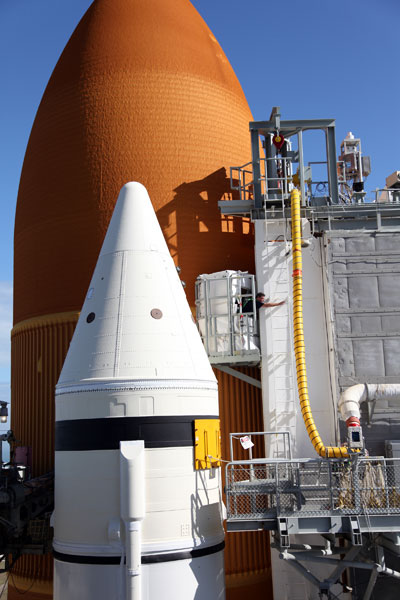
Technicians prepare Discovery's fuel tank for a tanking test. Credit: NASA
Crews working at Pad 39A are currently completing the installation of 89 strain gauges and temperature sensors for the tanking test to precisely record movement and temperatures from the intertank as it chills and warms again during the loading and emptying of cryogenic propellants. The tank holds super-cold liquid oxygen and hydrogen, which cause the tank to shrink by about half an inch.
Managers and engineers will review the data gathered from the tanking test and additional scans before determining the next course of action. Currently, managers plan to have Discovery returned to the launch pad in January ahead of its next opportunity to launch on the STS-133 mission, which is no earlier than Feb. 3 at 1:34 a.m. EST.
|
NASA pumped hundreds of thousands of gallons of super-cold propellant into shuttle Discovery's external tank on Friday morning to test why it had developed cracks along two support beams during a launch attempt last month.
The tanking test got underway at 7:00 a.m. EST (1200 GMT), when the three-hour fueling process began. It is scheduled to continue until 2:25 p.m. when the test's simulated launch countdown ends following a five minute hold at the T-minus 31 second mark.
Sensors installed on the tank will continue to collect data as the tank is emptied Friday afternoon and continue to record the tank's performance through Saturday as it warms to ambient temperature.

Wires lead to some of the strain gaguges and thermocouples for the test.
The test, which also serves to verify the repairs technicians made to the 154-foot tall tank, was proceeding without any noticeable issues. Results from the test were not expected immediately. Managers and engineers will review the data generated by the exercise before determining the next course of action.
"It looks like we're getting good data," said Mike Moses, NASA's shuttle launch integration manager at the Kennedy Space Center in Florida. "Like anything with a hazardous operation, it is nice and boring today, which is a good thing. Everything is looking like it is supposed to."
Discovery will launch no earlier than Feb. 3, 2011 on its final spaceflight before being retired. But first, the shuttle will be rolled off its launch pad and returned to the Vehicle Assembly Building (VAB) to undergo further tank inspections.
Cracked stringers
Friday's tanking test will help shuttle engineers determine what caused two 21-foot-long, U-shaped aluminum brackets, called stringers, to crack during the lead-up to a Nov. 5 attempt to launch Discovery. That launch attempt was called off not because of the cracks but rather due to an unrelated gaseous hydrogen leak that emanated from a cable connecting the tank to the pad.
The leak was eventually traced to a hardware alignment issue and was corrected. During Friday's test, no hydrogen was detected escaping from the umbilical.
During the Nov. 5 attempt, the cracked stringers caused their overlying foam insulation to crack as well, which is how NASA initially discovered the damage in the hours following the foiled countdown. In addition to the cracked beams posing a potential structural concern, cracks in the foam could cause the insulation to fall off during the shuttle's climb to orbit, creating a risk it might impact and damage the orbiter's heat shield.
Though NASA has encountered cracks in a tank's stringers before, they have always shown up during its assembly. This was the first time that cracks were found after the space shuttle was on the launch pad, leading engineers to wonder if they missed something during the fabrication or installation of the stringers.
"Either the stringer was the cause of the problem, that there was some assembly tolerance, some build up of stress in that part, or a crack that went through the system and we didn't see, that caused this stringer to break and so it is an isolated event — it is this stringer and that is the problem or the... stringer is a victim here and the design has a problem, the tank itself has a bigger issue to it, the loading had a problem and that there is something wrong generically that is causing the stress to be concentrated in this area that is never been there before," explained Moses.
Because shuttle engineers have not yet discovered the root cause for the damage, managers called for Friday's tanking test to gather more data.
Instrumented tank
Technicians outfitted the tank's ribbed midsection, or intertank region, with nearly 90 instruments, including strain gauges to precisely record movement and temperatures as the tank chilled and warmed again during the test's fuel loading and emptying process.
The tank holds more than 500,000 gallons of super-cold liquid oxygen at minus 297 degrees Fahrenheit and liquid hydrogen at minus 423 degrees. Earlier measurements have shown these cryogenic propellants cause the tank to shrink by about half an inch.
The test will provide more information about how the tank performs during fueling, as well as verify the repairs made to the cracked stringers. Technicians installed new sections of metal, called "doublers" because they are twice as thick as the original stringer metal, to replace the tops of the two cracked stringers.
"The point of the [test] is to gather performance data on the tank," Moses said. "We have stringers instrumented in the repair area so we can look and see how the repair performs under a cryo load. We have stringers instrumented next to that repair that aren't damaged, so we can see how they perform... and then on the opposite side of the tank, we have instrumented stringers to kind of go to a control-type theory, to say over here in a completely different area, here's how the tank performs."
The big picture moving forward
According to Moses, the test will generate more than five or six terabytes — 5,000 to 6,000 gigabytes — of data.
"All of that is going to be post-processed and shipped to the Michoud Assembly Facility [in Louisiana] and Marshall Space Flight Center [in Alabama] where the analysis will be done," said Moses. "That data will be there tonight. The expectation is by the weekend, we'll have reviewed all of that."
The data needs to be verified, though not analyzed, before Discovery can be rolled back to its assembly building for further study and to be readied for launch.
"We've decided to roll back to the VAB and so one of the go-no go's for that rollback is a report from that instrumentation team that they are happy with the data. That doesn't mean we've analyzed it and the results of the data are good but that we've captured good data," said Moses.
"We can then cut the wiring and de-configure the vehicle and be ready to rollback," he said.
Discovery is tentatively scheduled to begin its 3.4 mile (5.5 km) journey back to the VAB just after midnight on Tuesday, Dec. 21. Once inside, the fuel tank will undergo X-ray scans to examine the stringers along its backside. The tanking test instrumentation will also be removed, and — along with the installation of any modifications called for by the test data — the tank will be readied again for launch.
Meanwhile, shuttle managers will begin seeing the results from the test.
"Our big picture plan is that on Monday, Tuesday, Wednesday next week we'll start to get the results of that data in," said Moses. "It is going to take a while before we get all the fine details, but the big picture... all that's going to happen next week."
If all proceeds smoothly, Discovery will be returned to the launch pad in mid-January.
"We're going to have folks working around the country right through the Christmas holiday here to be ready to potentially fly again in this February launch window when it comes around," said Moses.
Discovery's next opportunity to embark on its 39th and final mission is scheduled for no earlier than 1:37 a.m. EST (0637 GMT) on Feb. 3.
|
Discovery's 3.4 mile roll from Launch Pad 39A to the Vehicle Assembly Building (VAB) was delayed early Tuesday morning to work an issue with the leveling system on the crawler-transporter used to move the shuttle.
Discovery had originally been scheduled to begin its six-hour rollback at 12:30 a.m. EST. The crawler was climbing the pad's incline when it was first observed that its upper surface — atop of which the shuttle and its mobile launch platform rides — had one corner higher than the others.
Engineers are working to resolve the height discrepancy, which is needed to keep Discovery level as it moves off the pad. It's believed that a faulty transducer is at fault, and it can be changed out to support rollback.
Teams are now targeting Wednesday evening, beginning at 10:00 p.m. at earliest, to begin the roll.
Once Discovery is back inside the VAB, technicians will X-ray the foam insulation surrounding the backside of the midsection, or intertank region, of the shuttle's external fuel tank to look for any issues, such as cracked stringers. They'll also remove sensors from the tank's aluminum skin and reapply foam following an instrumented tanking test on Dec. 17.
|
Discovery is secure inside its high bay for the holidays.
Anchored inside Kennedy Space Center's Vehicle Assembly Building, the shuttle completed the 3.4 mile (5.5 km) journey from Launch Pad 39A at 7:01 a.m. EST on Wednesday.
The move, known as a rollback, began Tuesday at 10:48 p.m. EST.
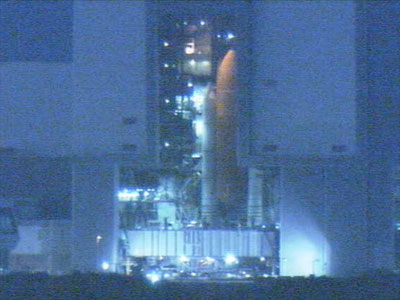
Discovery in the Vehicle Assembly Building after completing its rollback.
With Discovery now in place, technicians will begin X-ray scans beneath the foam of 108 support beams, called stringers, on Discovery's external fuel tank. They will also remove sensors that were added to the tank for last Friday's instrumented test and reapply foam to those areas.
On Tuesday afternoon, shuttle program managers decided to protect the option of performing known and practiced modifications to some of the stringers, if additional analysis indicates that is necessary. Managers are expected to decide on Dec. 30 whether the modifications are needed.
This was the sixth time Discovery has rolled back and 20th for the space shuttle program since the first in 1983. Discovery is expected to return to the launch pad in mid-January to support a no earlier than Feb. 3 liftoff.
|
Following Discovery's rollback to the Vehicle Assembly Building (VAB) on Dec. 22, engineers continued their work evaluating the intertank region on the shuttle's external fuel tank.
In addition to analyzing the data from the earlier performed tanking test, "non-destructive evaluation" was focused on stringers, or support beams, that were not accessible at the launch pad.
The X-rays revealed four more small cracks on the tops of three stringers on panel 6, which is on the opposite side of the tank from Discovery.
Shuttle managers have elected to repair the cracks in a fashion similar to the repairs that were made earlier to the cracks discovered after the Nov. 5 scrubbed launch attempt. That work is estimated to require two to three days.
Any further work -- including modifications to the tank -- will be evaluated early next week after additional data is reviewed. Hardware is in place to perform the modifications, if decided, while Discovery remains inside the VAB.
NASA is continuing to evaluate an option to perform known and practiced modifications on more of the tank's stringers. The decision may be made as early as Monday, Jan. 3.
Discovery's next available launch date is Thursday, Feb. 3 at the opening of a window that extends through Feb. 10.
|
Beginning Tuesday, shuttle technicians working in the Vehicle Assembly Building at NASA's Kennedy Space Center will modify 32 support beams, called stringers, in an effort to fortify Discovery's external tank for launch.
Crews will fit pieces of metal, called radius blocks, over the tops of the stringers located at the tank's thrust panel area to increase the structural support of the stringers. The thrust panel areas are located at the attach points between the fuel tank and the solid rocket boosters, which see the most stress during the flight into orbit.
The work is expected to require about one week.
Meanwhile, work continues to scan all 108 of the external tank's stringers using a backscatter device, allowing engineers to view the metal support beams below the foam insulation.
Managers will meet on Jan. 6 to determine if additional modifications are needed on the remaining stringers.
Repairs to cracks on three stringers on the opposite side of the tank from Discovery discovered on Dec. 29 began on Monday and are expected to be completed mid-week. The repairs are similar to those made on cracks found on two stringers after Discovery's Nov. 5 launch attempt.
Even with the time needed for the additional work, managers continue to target Discovery's launch for Feb. 3 at the start of a window that extends through Feb. 10.
|
Space shuttle Discovery will miss its early February opportunity to begin the STS-133 mission to give workers more time to fortify its external tank for launch, NASA announced Thursday.
Shuttle managers held their weekly program requirements control board meeting to review progress on the continuing engineering investigation, testing and analysis of the stringer cracks in Discovery's external tank. With the work remaining, the potential for additional modifications yet to be defined, and further reviews pending, the decision was made to allow the teams additional time and delay the next launch attempt out of the early February launch window, opening Feb. 3.
New dates for Discovery's STS-133 and Endeavour's STS-134 missions will be discussed at next Thursday's meeting. The next launch window is currently scheduled to open Feb. 27 and extend through March 6, though NASA is reviewing launch opportunities as early as Feb. 24.
Progress continues to be made toward understanding the most probable cause of cracks discovered on Discovery's external tank mid-section, known as the intertank, where small cracks developed during the Nov. 5 launch attempt. Four additional small cracks were found during thorough X-ray image scans of the backside of the tank after Discovery returned from its launch pad to the Vehicle Assembly Building (VAB) at NASA's Kennedy Space Center on Dec. 22.
Plans are for the repair work to continue through the weekend. Managers also reviewed a proposal to modify as many as 32 more of the stringers with radius blocks to provide added structural support in areas known to carry much of the structural load of the external tank. These blocks fit over existing stringer edges to provide additional structural support.
This work should begin as soon as the repairs to the three stringers with the four additional small cracks have been completed, likely in the next day or so, and the modification of the additional 32 stringers is expected to be complete next week.
Senior NASA managers and shuttle program managers will meet Monday to review the progress and forward plan. A determination of the need and viability for the installation of additional radius blocks on all the remaining stringers will be made sometime next week.
|
NASA managers declared Tuesday that they had complete confidence in their plan to ready space shuttle Discovery for a launch on Feb. 24.
"I'm very confident that we finally got it figured out," said shuttle program manager John Shannon. "We have a fix that's easy to implement and will be a hundred percent effective."
That fix — which addresses the risk of support beams called stringers on the external tank's intertank region cracking — calls for the installation of additional hardware to strengthen each beam.
"The radius block is a small piece of 2024 aluminum [alloy]. It's about six inches long [and] about a fifth of an inch thick and it is curved — that is why we call it 'radius,'" explained Shannon.
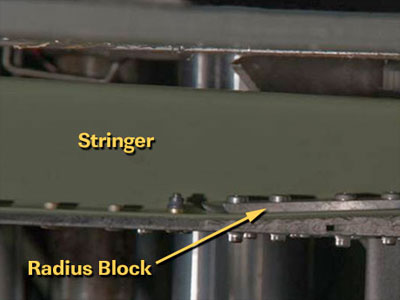
Installation location of the radius block. Credit: NASA
Installing the radius blocks keep the feet of the stringers flat against the tank, preventing them from bending, which could then lead to cracking. They redirect the stresses imparted by the load of super-cold propellants into the tank and then the launch itself to the top of the stringers, which has a much greater capability than the feet do.
"By just putting this very small piece of aluminum over the top... keeping the feet nice and flat, you increase the capability of that area by about three-and-a-half to four times," said Shannon. "It's a very simple, elegant fix to the problem."
Finding the root cause(s)
Before shuttle engineers could arrive at this "simple fix," they needed to identify the cause of the cracks, which proved to be much more difficult.
"It's been a difficult problem for us because it wasn't easily understood," described associate administrator for space operations Bill Gerstenmaier. "As we went through fault tree analysis and looked at various problems, we would think we had the leading cause for a while. We would then go do another test, we would discover something new, and then we'd have to postulate a new failure mode and continue to press on."
The break, as it was, came on Dec. 31.
"Finally on our New Year's Eve test, we were able to replicate a flight-like cracking," Shannon recounted. "This was a big moment for us because we were able to show that we could crack the stringers [in a way] very similar to what we were seeing on the vehicle."
After weeks of testing, which resulted in engineers ruling out there being any gross problems with the tank but being unable to narrow the cause to just one issue, they came to understand the cracking was a combination of two factors.
"The team noticed that the appearance of [some of the stringers installed on Discovery's external tank] was different than the [stringer] material we had been testing before," said Shannon.

"Mottled appearance" of the stringer material. Credit: NASA
The "rougher, mottled" looking stringers prompted engineers to examine the aluminum alloy under a scanning electric microscope and at fracture planes. They found that the mottled appearance was caused by a slightly different grain structure that could be caused by a different heat treating of the material.
The change in heat treatment had caused the stringer material to become stronger but less ductile. But that it was less pliable — or as referred to by NASA, had a "lower fracture toughness," — proved not to be the only cause.
"When we tested [a stringer] that had this lower fracture toughness in the test rig, it still was able to carry loads that were greater than what you would see during cryo loading or during flight," said Shannon. "So the lower fracture toughness wasn't the complete answer."
Shuttle engineers found that the stringers that had cracked experienced increased stresses due otherwise minor problems in the way they were assembled.
"In looking at those stringers that had cracked, we're seeing evidence of those assembly stresses that combined with that low fracture toughness caused the problem," said Shannon. "So we have root cause and we have a fix that we're completely confident will eliminate the root causes."
The path forward to a Feb. 24 launch
Work to install the radius blocks on 94 out of the total 108 stringers on Discovery's external tank began over the weekend and is expected to be completed around Jan. 23.
Shortly thereafter, Discovery will be returned to Pad 39A from the Vehicle Assembly Building, to be readied for a no sooner than Feb. 24 launch.
The target date is several days earlier than what was originally stated as the "no earlier then" window opening on Feb. 27.
"Once our shuttle program colleagues got to the point where they felt comfortable with the repair and the date they thought they could make, we went to look to see if we could open up the late February window any to give us more opportunities to launch," explained International Space Station program manager Michael Suffredini. "We think we can support a launch date of the 24th of February."
The change was made possible by having the Russians and Europeans agree to overlap on-orbit preparations for both a Russian spacewalk set for Feb. 21 and the arrival at the station of the European Space Agency's Automated Transfer Vehicle (ATV) supply craft to be launched Feb. 18.
|
Preparations to launch space shuttle Discovery on Feb. 24 continue this week, despite NASA having to replace an injured STS-133 crew member.
On Saturday, mission specialist Tim Kopra was injured in a bike accident near his home in Houston, Texas. By Wednesday, NASA had determined he would be unable to meet his mission duties, including two spacewalks and serving as flight engineer for launch and entry.
Astronaut Stephen Bowen, who last flew on the previous shuttle mission, STS-132 in May 2010, will begin training with the crew this week.
"Tim is doing fine and expects a full recovery however he will not be able to support the launch window next month," said Peggy Whitson, chief of the Astronaut Office at NASA's Johnson Space Center in Houston. "If for some unanticipated reason STS-133 slips significantly, it is possible that Tim could rejoin the crew."
Article: NASA replaces injured astronaut on Discovery's final flight
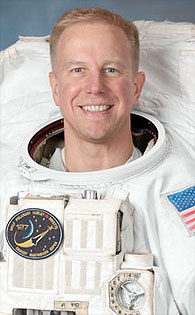 
Tim Kopra (left) will be replaced by Steve Bowen (right). Credit: NASA
Meanwhile, inside the Vehicle Assembly Building (VAB) at the Kennedy Space Center in Florida, shuttle technicians continue the installation of support structures, called radius blocks, on Discovery's external tank.
The radius blocks are being added to 94 of the external tank's support beams, called stringers, meaning the entire circumference of the tank will be strengthened by the time all the repairs and modifications are finished.
|
Space shuttle Discovery repeated history on Monday evening, making its final trip to the launch pad — for the second time.
Discovery, NASA's oldest flying orbiter and first shuttle to reach its final mission, was previously rolled to the pad last September, but unexpected damage to its external tank required it be brought back and extensively repaired.
Discovery began the 3.4-mile rollout from the Vehicle Assembly Building at NASA's Kennedy Space Center to Launch Pad 39A at 7:58 p.m. EST. The shuttle, mounted to its twin solid rocket boosters and newly-fortified external tank, was moved on top of its mobile launch platform by one of NASA's two Apollo-era crawler transporters.
Reaching a maximum speed of about one mile per hour (mph), the move marks Discovery's 45th and final trip to the pad and is expected to take about six hours to complete.
UPDATE: Discovery reached Launch Pad 39A at 2:55 a.m. EST.
Photo Gallery: Discovery rolls out for the final time, again

Discovery is bathed in Xenon light as it rolls to Pad 39A Credit: collectSPACE
Once back on the pad, Discovery will again undergo final preparations to launch on its STS-133 mission to the International Space Station.
NASA has targeted Feb. 24 at 4:50 p.m. EST for Discovery's 39th and final launch. The 11-day mission is the third-to-last on NASA's manifest for its 30-year old space shuttle program.
The mission was originally scheduled to launch last November, but after a hydrogen leak scrubbed its first attempt, shuttle technicians discovered a crack in Discovery's external tank insulating foam. A closer inspection of the area revealed underlying cracks in the tank's U-shaped aluminum support beams, called stringers.
Though cracked stringers had earlier been encountered during assembly of the tanks, NASA had never found them once the shuttle was on the launch pad. Unable to arrive at a root cause, shuttle engineers installed sensors on the tank while Discovery was still on the pad and then fueled it as they would on a launch day to gather more information about what might have triggered the cracks.
As the data from the "tanking test" was processed, NASA rolled back Discovery to its 52-story assembly building to further X-ray the tank and perform repairs. Additional cracked stringers were found on the backside of the tank — and coupled with the results of the fueling test — NASA decided to strengthen most of the 94 beams using support fixtures called radius blocks.
Technicians completed installation of the additional hardware and applied new foam to the fuel tank this past week. Soon after, managers cleared Discovery to return to the launch pad.
|
Technicians working at NASA Kennedy Space Center's Launch Pad 39A will begin Tuesday inspecting and replacing the 7-inch quick disconnect seal at space shuttle Discovery's ground umbilical carrier plate (GUCP).
The repair, which aims to ensure the seal's connection to the vent line, is focused on the same hardware that last November leaked hydrogen gas, scrubbing Discovery's first STS-133 launch attempt.
Following a recently reviewed analysis of the vent line weight distribution, engineers decided to replace the seal with the same enhanced process used prior to the successful tanking test in December 2010.
Once the seal has been replaced and the plate reconnected, technicians will perform additional leak checks on the system. Work is not expected to delay Discovery's targeted launch on Feb. 24.
|
Wednesday night (Feb. 8), while technicians were taking measurements to replace Discovery's ground umbilical carrier plate, or GUCP, a "feeler gauge" came apart and some of its components fell from the work area.
Feeler gauges are comprised of 13 metal pieces about the thickness of a piece of paper held together by a retainer screw.
Overnight, technicians performed a walk down of the pad to assess any impact from the fall and collect the gauge components prior to resuming work on the GUCP. Additional walk downs began at daylight. Engineers will identify, evaluate, and address any damage to the space shuttle and its external tank and solid rocket boosters.
As that assessment continued, technicians replaced Thursday the 7-inch quick disconnect seal on Discovery's GUCP.

Example of a feeler gauge. (file photo)
Update (Feb. 9, 8:32 p.m. CST): Engineers have identified that the feeler gauge caused minor damage to the foam on the backside of Discovery's external tank, which will not need repair. All components from the gauge have been located.
|
Space shuttle Discovery is scheduled to begin an 11-day mission to the International Space Station with a launch at 4:50 p.m. EST on Thursday, Feb. 24, from NASA's Kennedy Space Center in Florida. The STS-133 mission is Discovery's final scheduled flight.
Discovery's launch date was announced Friday at the conclusion of a flight readiness review at Kennedy. During the meeting, senior NASA and contractor managers assessed the risks associated with the mission and determined the shuttle's and station's equipment, support systems, and personnel are ready.
"We had a very thorough review today," said Bill Gerstenmaier, NASA's associate administrator for space operations. "I think we are ready to go next week and we are ready for launch."
Before Discovery can liftoff to the station however, the European Space Agency's Automated Transfer Vehicle-2 "Johannes Kepler" first needs to safely dock with the orbiting complex. Launched Feb. 16, the unmanned cargo craft is scheduled to arrive at the station just as the space shuttle is finished being loaded with its propellants.
"The ATV is going to dock about six hours before we launch," said Mike Moses, NASA's shuttle integration manager. "We will have tanked the vehicle by then. If they run into a problem during docking, we still might launch that day, we might not -- we will have to talk about that one in real time."
The ATV's arrival and Discovery's docking will bring to the space station the final components for a potential "family photo," still to be approved by STS-133 mission managers.
If given the go, three of the station's crew members will board one of two Russian Soyuz spacecraft currently berthed at the complex, undock and move away to capture photographs and video of the nearly-complete ISS together with the shuttle and vehicles from Russia, Japan and Europe.
"It is okay from a flight readiness review standpoint, but it is really up to the team to see what happens," said Gerstenmaier.
If the photo op proceeds, Discovery will gain an extra day in space prior to departing from the station and making its final return to Earth.
|
The six astronauts who will fly space shuttle Discovery's final spaceflight arrived Sunday afternoon at NASA's Kennedy Space Center in Florida, in preparation for their scheduled launch on Thursday.
STS-133 mission commander Steven Lindsey led his crew to a 3:45 p.m. EST landing on the Shuttle Landing Facility, the same runway where he'll ultimately land Discovery for its last return from space.
"We're ready to fly, we're anxious for hopefully good weather and a good vehicle to launch and go up to the space station," said Lindsey.
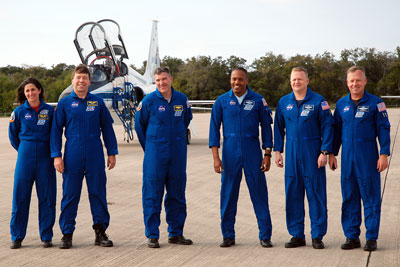
Discovery's final crew arrives for launch. Click to enlarge. Credit: collectSPACE
The astronauts came to Florida from Johnson Space Center in Houston, Texas, flying in four T-38 training jets.
Lindsey flew in with mission specialist Al Drew. Pilot Eric Boe was paired with mission specialist Mike Barratt. Nicole Stott and Stephen Bowen flew in the backseat of two T-38s with astronaut pilots not on their crew.
This was the second time for all but one of the crew to arrive at Kennedy with plans to launch on the STS-133 mission. A hydrogen leak on Nov. 5, 2010, led to shuttle engineers discovering cracks in Discovery's external tank and in the months that followed, a member of the crew was injured and replaced.
"The external tank problem we have been working for the past couple of months is probably one of the most difficult technical challenges we've faced in recent years," said Lindsey. "But the team came together, doing a great job figuring out a very difficult engineering problem and coming up with a solution that I think gives us a really good tank to go launch with this week."
"The second challenging thing to happen to us," continued Lindsey, "Tim Kopra was injured and we lost Tim as a crew member here about four or five weeks ago. So we have had a real challenging training flow to try to bring Steve Bowen in and get him up to speed to take Tim's place."
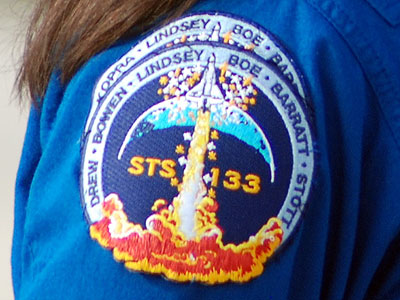
Mission specialist Nicole Stott arrived in Florida wearing a mission patch displaying Bowen's name sewn over the original, which included Kopra. Credit: collectSPACE
Lindsey said that were it not for Kopra's help re-planning their mission's two spacewalks and helping his former crew members assume his tasks, they would not have been ready to fly now.
"If it was not for Tim developing our EVAs as our lead spacewalker and doing a fantastic job with that, as well as doing a great job as flight engineer on the flight deck in ascent and entry working with Nicole and Al in that capacity, we couldn't have pulled this off in four weeks of training to be ready to go. But I'm happy to say our training is complete and we're ready to go."
"Steve Bowen has jumped into the crew and done just a fantastic job to learn Tim's roles in the EVAs and Nicole and Al have jumped up to the flight deck to take over Tim's role there and has done a fantastic job with that," Lindsey remarked.
Bowen acknowledged that he had his work cut out for him.
"I've got big shoes to fill," said Bowen. "Tim and Al did a great job pulling this all together well before I got involved. I hope to be able to execute the plan as well as I can. I'm sure I won't I be able to fill it as well as Tim and Al could but we'll see how this works out."
The crew will spend the next few days in quarantine, reviewing their flight plans and, in the case of Lindsey and Boe, practicing landing the shuttle using NASA's modified-Gulfstream training aircraft.
The countdown to their liftoff on Thursday at 4:50 p.m. EST will begin on Monday at 3:00 p.m.
|
Countdown clocks at the Kennedy Space Center are now ticking toward the scheduled last launch of the space shuttle Discovery.
The official countdown started at 3:00 p.m. EST inside Firing Room 4 of the Launch Control Center (LCC). Launch team members gathered for the "call-to-stations" a half hour earlier.
The count began at the T-minus 43 hour mark. A series of planned holds are timed throughout the next few days, leading to the targeted liftoff time of 4:50 p.m. on Thursday.
Countdown milestones
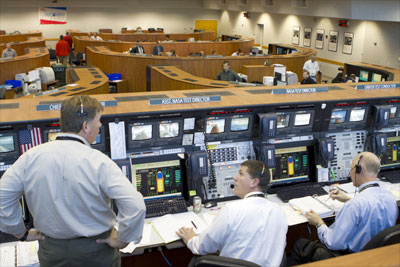
STS-133 Asst Test Director Jeff Spaulding (left) with NASA Test Director Jeremy
Graeber and STS-133 NASA Test Director Steve Payne in Firing Room 4. (NASA)
NASA Test Director Jeff Spaulding gave an overview of the countdown's milestones leading to Discovery's liftoff.
With the count now underway, "[we] get right into our final checkout and configuration of our on board avionics systems and then we will work preparations for fuel cell reactants later tonight," said Spaulding.
The reactants — liquid hydrogen and liquid oxygen — power the orbiter's three fuel cells, which provide the electricity for the shuttle's systems.
"Seven o'clock tomorrow morning, we will clear the pad for the loading of those reactant operations and continue those preps until the actual loading, which starts at 12:30 in the afternoon."
See the STS-133 launch countdown milestones and times
"We expect the pad to open up at about 6:00 tomorrow evening from that op and then we will continue with about 120 pounds of liquid oxygen that we continue to offload of the vehicle to get us to our appropriate flight load and flight mass for that system, which is about four more hours of work to do there."
"We will proceed with our checkout of orbiter and ground communication systems and all of the networks associated with those on Wednesday afternoon at about 2:30, followed then by our final flight crew equipment stowage operations at about 4:00."
"On Wednesday evening the rotating service structure will be pulled back away from the vehicle and the xenon lights will be turned on, revealing the vehicle in its launch form for the last time. And that will be about 8:00 on Wednesday evening when we do that."
"Then, as we go just past midnight at about 12:30 or so, our countdown clock will resume from T-minus 11 hours and at that point we'll begin our final loading preparations and begin clearing the pad about 2:00 a.m. on Thursday morning."
"Our earliest tanking time is at 7:25 on Thursday morning. It takes about three hours, as normal, and then we will bring the flight crew out once we get the crew module configured at about 1:30 on Thursday afternoon."
"Our launch window is about ten minutes or so in length. It opens at 4:45 on Thursday the 24th. We will target the middle of that window, which correlates to about 4:50 p.m," Spaulding concluded.
Weather permitting
Launch day weather is shaping up nicely, with the current forecast calling for an 80 percent chance of acceptable conditions.
"On launch day, everything looks good right now," Kathy Winters, shuttle weather officer, said on Monday. "If we do happen to delay a couple of days, then it does become a concern. We start having increased concern for low cloud ceilings."
|
Preparations to launch space shuttle Discovery on Thursday, Feb. 24 are continuing as technicians put the finishing touches on the spacecraft and the launch team runs through the countdown. Liftoff is scheduled for 4:50 p.m. EST when the forecast calls for an 80 percent chance of acceptable weather conditions.
"Our launch countdown is proceeding smoothly and is on schedule," said Steve Payne, NASA Test Director for the STS-133 mission.
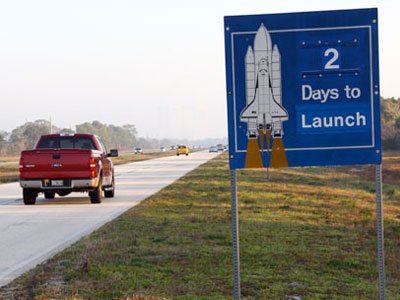
Photo credit: NASA
Loading Discovery's PRSD for flight
"We have now completed checkout and configuration of the avionics systems. We've completed preparations for fuel cell reactant loading and have cleared our pad. We have completed our pyrotechnic systems and range safety system checks and they were successful. We're scheduled to begin purging the midbody with inert gas shortly in preparation for the reactant loading, which should begin around 12:30 this afternoon," Payne reported.
Liquid oxygen and liquid hydrogen will be loaded into Discovery's Power Reactant Storage and Distribution system. Known by its initials PRSD, the system holds the chemicals for use in the shuttle's three fuel cells to produce electricity in space. The oxygen is also used to pressurize the shuttle's crew cabin.
The combination of hydrogen and oxygen in the fuel cells also produces a byproduct for the shuttle: water. Shuttle crews visiting the International Space Station routinely fill up bags with their excess water for use by the station's residents.
The same two chemicals, liquid oxygen and liquid hydrogen, are used by the space shuttle main engines at liftoff, but the propellants for that job go into the 15-story-tall external fuel tank and are not loaded until launch day.
"We should be loading [the PRSD] through about 6:00 p.m. tonight, at which point we will reopen the pad and go into a four hour off-load period where we'll take off approximately 120 pounds of liquid oxygen. We'll also begin initial ground systems preparations for external tank loading on Thursday morning," said Payne.
A minor problem
"We are working only one minor issue," Payne said. "We have a slight internal leakage on a reaction control system [RCS] regulator. However, we have seen this condition before. It is well within acceptable limits and we're going to accept it for flight. It should be waived here shortly."
According to Payne, the "very slight" leak, which was discovered Sunday night, was seen during the countdown to Discovery's STS-116 mission in 2006.
"We had [this] back on STS-116 with a larger leak rate and we accepted it because we had a workaround that was good," he said.
That workaround involves isolating the leak by closing a redundant leg of the system.
"We have a number of redundant systems in our reaction control system. We have a helium tank that pressurizes our propellant tanks. It is fed through two separate legs, each of which has redundant regulators that can adjust the pressure," explained Payne.
"One regular on one leg has a slight leak, which means that instead of shutting off completely like it should, a slight amount of helium is going into the propellant tank and adding a little more pressure in there than we typically would like. What we generally do is just shut off that leg. We isolate it and it doesn't leak any more and we are okay."
|
NASA's mission management team have given their unanimous approval for space shuttle Discovery's launch tomorrow at 4:50 p.m. EST.
"Everything is on track, going beautifully with the countdown and we are more than ready for tomorrow's launch," said Mike Moses, the team chair and NASA's shuttle integration manager.
"Everything is going extremely well in the countdown for Discovery's last mission," added launch director Mike Leinbach. "We're not tracking any issues and Discovery looks like she'll fly this time."
The weather forecast for launch time remains at just a 20 percent chance of prohibitive conditions. According to weather officer Kathy Winters, the only issue may be a localized off-shore shower in the late afternoon.
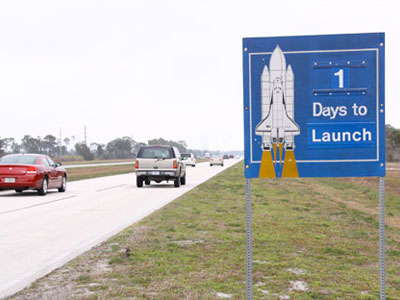
Photo credit: NASA
Discovery on the pad for the last time
"We got a good load on our PRSD system yesterday — that is the liquid oxygen and liquid hydrogen for the fuel cells," reported Leinbach.
"The next major activity tonight at eight o'clock will be the retraction of the rotating service structure, giving everybody a good view of Discovery on the pad for the last time."
The 102-foot long by 130-foot high rotating service structure protects the orbiter on the launch pad while allowing for the installation and servicing of payloads, as well as access to certain shuttle systems. The structure is retracted 120 degrees before launch, revealing the orbiter and setting the stage for the shuttle's external tank to be loaded with its propellants.
"Tomorrow morning, we will get together at about seven o'clock and talk weather for tanking. The forecast looks pretty good, so we expect to be tanking at about 7:25," said Leinbach.
Action-packed mission
"We're ready to fly STS-133, we've been ready from a mission standpoint for quite a while and now our hardware is in line and ready to go," Moses said.
"We're delivering the PMM, the Permanent Multipurpose Module, which will basically be a really good addition to [the] space station in terms of storage capability on-orbit."
"We are about ready to add that module to the "piazza d'Italia," as my Italian friends call it," payload manager Scott Higginbotham said. That's the growing collection of Italian-built hardware on the International Space Station."
"The module is carrying up about 8,500 pounds of cargo, including the ExPRESS Rack 8 research facility and... our little friend, Robonaut 2."
R2, as Robonaut 2 is also called, is the first dexterous humanoid robot designed to assist astronauts inside and eventually outside the station.
"As far as we know, we have not heard any knocking sounds or muffled cries of 'Are we there yet?' coming from the module. Ends up Robonaut is powered down and he can't speak," Higginbotham joked. "He's ready to go in his enclosure and go to work in space."
In addition to the Leonardo PMM, Discovery is also launching a pallet for and with spare equipment.
"We're taking the ELC-4 external logistics cargo pallet, which has a spare radiator and room for other spare hardware once it gets on-orbit and gets stowed on the space station," said Moses.
"On top of that ExPRESS Logistics Carrier, we've what we affectionately call, the 'big hunkin' radiator,' the largest [orbital replacement unit] we've ever flown on the shuttle. Hopefully, we will never have to use it but we'll have it up there if we do need it," said Higginbotham.
Adding to the payload in the cargo bay, Discovery is also launching 1500 pounds of equipment on its middeck.
"That cargo complement has changed [since STS-133 first attempted to launch on Nov. 5] as we did have access to that hardware and as space ops are dynamic, the needs of the space station have changed since we last attempted to go fly," explained Higginbotham.
"We've taken advantage of the opportunity to shuffle some things around between this mission, [ESA's] ATV that just launched, [JAXA's] HTV that just launched and [Russian] Progress missions. Fortunately with lots of different vehicles carrying cargo to the station, we can make those kinds of choices."
Shuttle technicians began repacking the middeck on Monday and are set to finish tonight.
"At that point, the entire [STS-133] compliment will be onboard and ready to go fly," said Higgonbotham.
"We're really looking forward to a very action-packed successful mission and everything is on track," said Moses.
|
Space shuttle Discovery was revealed on its launch pad for the final time Wednesday night, as the rotating service structure at the Kennedy Space Center's Pad 39A was pulled back in preparation for Thursday's 4:50 p.m. EST scheduled liftoff of the STS-133 mission.
Photo Gallery: Discovery revealed for final flight
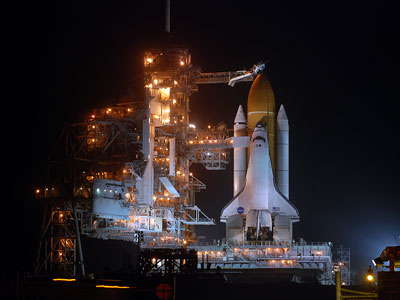
Discovery is revealed on Launch Pad 39A. Photo credit: collectSPACE
The 102-foot long by 130-foot high rotating service structure protects the orbiter on the launch pad while allowing for the installation and servicing of payloads, as well as access to certain shuttle systems. The structure is retracted 120 degrees before launch, revealing the orbiter and setting the stage for the shuttle's external tank to be loaded with its propellants.
Shuttle technicians began moving the pad structure away from Discovery at 8:02 p.m. and had it fully retracted 35 minutes later at 8:37 p.m.
|
Fueling of Discovery's external tank with 535,000 gallons of liquid oxygen and hydrogen is now underway.
Space shuttle mission managers met at 7 a.m. EST and gave a "go" to begin loading Discovery's external fuel tank with its super-cold cryogenic propellants. The operation began on time at 7:25 a.m. EST and will take approximately three hours.
The first phase of the fueling is called "slow fill" to allow the pumps, lines and tank to condition themselves to the super cold chemicals. The liquid oxygen is at minus-297 degrees Fahrenheit and the liquid hydrogen is at minus 423 degrees F.
The weather forecast has improved from Wednesday. There is now just a 10% chance that the conditions will be prohibitive at launch time. At 4:50 p.m. EST, the forecast calls for scattered clouds at 3,000 and 25,000 feet, good visibility, southeasterly winds of 14 knots gusting to 20 knots and a temperature of 73 degrees.
Teams are not working any issues that would delay today's liftoff.
The STS-133 astronauts woke at 7 a.m. and, after having breakfast, are soon to undergo pre-launch medical checks.
|
Space shuttle Discovery's external tank has now been filled with 535,000 gallons of liquid hydrogen and liquid oxygen.
"Fast fill" of the tank began at 8:15 a.m. EST with liquid oxygen and one minute later for the liquid hydrogen. Fueling reached "stable replenish" of both cryogenic propellants at 10:19 a.m. Liquid hydrogen (LH2) "topping" began at 9:58 a.m.
The three-hour tanking process, which began at 7:25 a.m. EST, provides the fuel and oxidizer that Discovery's three main engines will need for the eight and a half minute climb into orbit, scheduled to begin with a liftoff at 4:50 p.m. EST.
Unlike Discovery's first launch attempt on Nov. 5, no gaseous hydrogen was seen leaking from the ground umbilical carrier plate, or GUCP, during tanking. Technicians replaced the plate's hardware — which conveys any excess hydrogen away from the shuttle and pad — following that scrub.
The forecast calls for an 90% chance of good weather for launch, and no technical issues are being worked that would prevent an on-time liftoff.
|
The STS-133 astronauts left their crew quarters to depart for Launch Pad 39A at 1:00 p.m. EST, riding the "AstroVan," a modified Airstream trailer. They arrived 15 minutes later to board their ride the International Space Station, space shuttle Discovery.
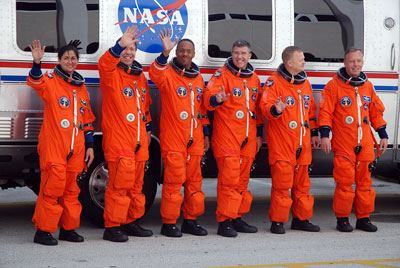
STS-133 waves before leaving for Discovery. Credit: collectSPACE
Commander Steven Lindsey, pilot Eric Boe and mission specialists Alvin Drew and Nicole Stott are boarding Discovery to take their seats on the flight deck.
Mission specialists Stephen Bowen and Michael Barratt will ride to space on the shuttle's middeck.
With all the astronauts onboard, the closeout crew will close Discovery's hatch, pressurize the crew cabin, check for leaks, and then finish up their work inside the White Room prior to leaving the pad.
|
Flight Day Archive: Countdown • 1 • 2 • 3 • 4 • 5 • 6 • 7 • 8 • 9 • 10 • 11 • 12 • 13 • 14

© 2022 collectSPACE.com All rights reserved.
Questions? E-mail contact@collectspace.com
|
|
 advertisements advertisements
|
|
































